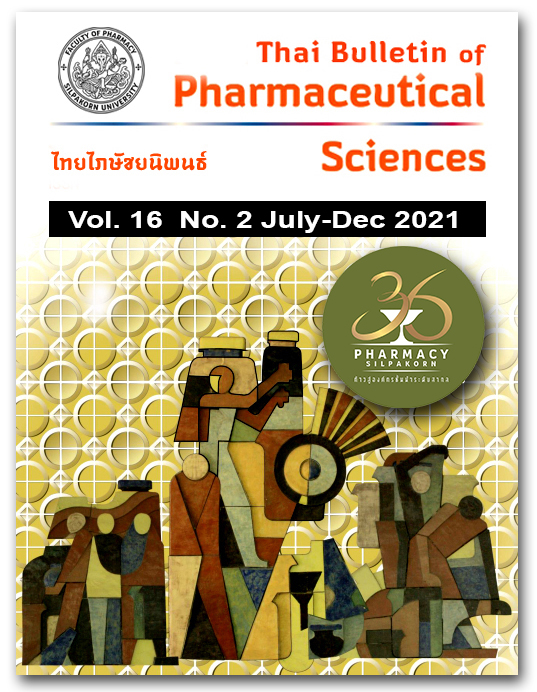DEVELOPMENT OF SKIN ANTI-POLLUTION FILM-FORMING SPRAY
DOI:
https://doi.org/10.69598/tbps.16.2.47-59Keywords:
film-forming spray, anti-pollution product, hydroxypropyl methylcellulose, biosaccharide gumAbstract
The aim of this study was to develop topical skin anti-pollution film-forming spray by simple solution method. The film-forming sprays were developed using 2 types of hydroxypropyl methylcellulose (HPMC E5 and E15) and plasticizers (polyethylene glycol: PEG; propylene glycol: PG; glycerin:G). Biosaccharide gum (1% w/v), which is an active ingredient, was used. The film-forming sprays composed of a film-forming polymer i.e. HPMC E5 or HPMC E15 (2% w/v) along with PEG, PG, and G (0.2% w/v) showing good film appearance and short skin evaporation time were subjected to the evaluation of parameters related to formulation and container. The results revealed that the film-forming spray composed of 2% w/v of HPMC E5 and 0.2% w/v PG (E5-PG) gave non-sticky, clear, colorless film with a smooth surface. The evaporation times of E5-PG tested on skin and bagasse paper were 4.28 and 14.33 min, respectively. The viscosity of E5-PG formulation was 10.55 mPa·s. The formulation could be sprayed with a high spray coverage area of 71.70 cm2. The volume of solution delivered upon each actuation and spray angle of E5-PG were 139.8 µL and 79.80 degrees, respectively. In addition, E5-PG showed percentages of fine particulate matter protection property at 93.84 and 63.57% compared to the control 1, which had no barrier, and control 2, which had filter cloth as a barrier, respectively. In the skin irritation study conducted on 30 human volunteers, E5-PG did not cause any irritation. In conclusion, E5-PG has the potential for use as an anti-pollution film-forming spray.
References
Baudouin C, Charveron M, Tarroux R, Gall Y. Environmental pollutants and skin cancer. Cell Biol Toxicol. 2002;18:341-8.
Drakaki E, Dessinioti C, Antoniou CV. Air pollution and the skin. Front Environ Sci. 2014;2:11.
Piao MJ, Ahn MJ, Kang KA, Ryu YS, Hyun YJ, Shilnikova K, et al. Particulate matter 2.5 damages skin cells by inducing oxidative stress, subcellular organelle dysfunction, and apoptosis. Arch Toxicol. 2018;92:2077-91.
Vierkötter A, Schikowski T, Ranft U, Sugiri D, Matsui M, Krämer U, et al. Airborne particle exposure and extrinsic skin aging. J Invest Dermatol. 2010;130:2719-26.
Kim KE, Cho D, Park HJ. Air pollution and skin diseases: Adverse effects of airborne particulate matter on various skin diseases. Life Sci. 2016;152:126-34.
Mistry N. Guidelines for formulating anti-pollution products. Cosmetics. 2017;4:57.
McAuley WJ, Caserta F. Film-forming and heated systems. In: Donnelly RF, Singh TR. Novel delivery systems for transdermal and intradermal drug delivery. New Jersey: Wiley-Blackwell; 2015. p. 97-124
Higuchi T. Physical chemical analysis of percutaneous absorption process from creams and ointments. J Soc Cosmet Chem. 1960;11:85-97.
Ishii H, Todo H, Sugibayashi K. Effect of thermodynamic activity on skin permeation and skin concentration of triamcinolone acetonide. Chem Pharm Bull. 2010;58:556-61.
Fiume MM, Heldreth B, Bergfeld WF, Belsito DV, Hill RA, Klaassen CD, et al. Safety assessment of microbial polysaccharide gums as used in cosmetics. Int J Toxicol. 2016;35(1_suppl):5S-49S.
Kanlayavattanakul M, Lourith N. Biopolysaccharides for skin hydrating cosmetics. In: Ramawat KG, Mérillon JM. Polysaccharides: Bioactivity and Biotechnology. New York: Springer International Publishing; 2015. p.1867-92.
Mori NM, Patel P, Sheth NR, Rathod LV, Ashara KC. Fabrication and characterization of film-forming voriconazole transdermal spray for the treatment of fungal infection. Bull Fac Pharm Cairo Univ. 2017;55:41-51.
Narda M, Bauza G, Valderas P, Granger C. Protective effects of a novel facial cream against environmental pollution: In vivo and in vitro assessment. Clin Cosmet Investig Dermatol. 2018;11:571.
Milani M, Hashtroody B, Piacentini M, Celleno L. Skin protective effects of an antipollution, antioxidant serum containing Deschampsia antartica extract, ferulic acid and vitamin C: A controlled single-blind, prospective trial in women living in urbanized, high air pollution area. Clin Cosmet Investig Dermatol. 2019;12:393.
Gohel MC, Nagori SA. Fabrication of modified transport fluconazole transdermal spray containing ethyl cellulose and Eudragit® RS100 as film formers. AAPS Pharm Sci Tech. 2009;10:684-91.
OECD guideline for testing of chemicals acute dermal Irritation/corrosion [Internet]. Paris: Organisation for Economic Co-operation and Development; c2015 [cited 2021 Mar 09]. Available from: https://www.oecd-ilibrary.org/environment/test-no-404-acute-dermal-irritation-corrosion_9789264242678-en.
Sahoo CK, Rao SR, Sudhakar M. HPMC a biomedical polymer in pharmaceutical dosage forms. Chem Pharm Sci. 2015;8:875-81.
Abd Kakhar Umar MB, Sriwidodo S, Wathoni N. Film-forming sprays for topical drug delivery. Drug Des Devel Ther. 2020;14:2909.
Vanti G, Wang M, Bergonzi MC, Zhidong L, Bilia AR. Hydroxypropyl methylcellulose hydrogel of berberine chloride-loaded escinosomes: Dermal absorption and biocompatibility. Int J Biol Macromol. 2020;164:232-41.
Punitha S, Uvarani R, Panneerselvam A. Effect of pH in aqueous (hydroxy propyl methyl cellulose) polymer solution. Results Materials. 2020;7:100120.
Lachenmeier, DW. Safety evaluation of topical applications of ethanol on the skin and inside the oral cavity. J Occup Med Toxicol. 2008;3:1-6.
Sulekha B, Avin G. Topical spray of silver sulfadiazine for wound healing. J Chem Pharm Res. 2016;8:492-8.
Bühler V. Polyvinylpyrrolidone excipients for pharmaceuticals: povidone, crospovidone and copovidone. Berlin. Springer Science & Business Media; 2005.
Paradkar M, Thakkar V, Soni T, Gandhi T, Gohel M. Formulation and evaluation of clotrimazole transdermal spray. Drug Dev Ind Pharm. 2015;41:1718-25.
Air Quality Index (AQI) [Internet]. Danbury (CT): Home of the U.S. Air Quality Index [cited 2021 March 14]. Available from: https://www.airnow.gov/aqi/
Downloads
Published
How to Cite
Issue
Section
License
All articles published and information contained in this journal such as text, graphics, logos and images is copyrighted by and proprietary to the Thai Bulletin of Pharmaceutical Sciences, and may not be reproduced in whole or in part by persons, organizations, or corporations other than the Thai Bulletin of Pharmaceutical Sciences and the authors without prior written permission.



